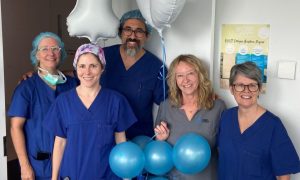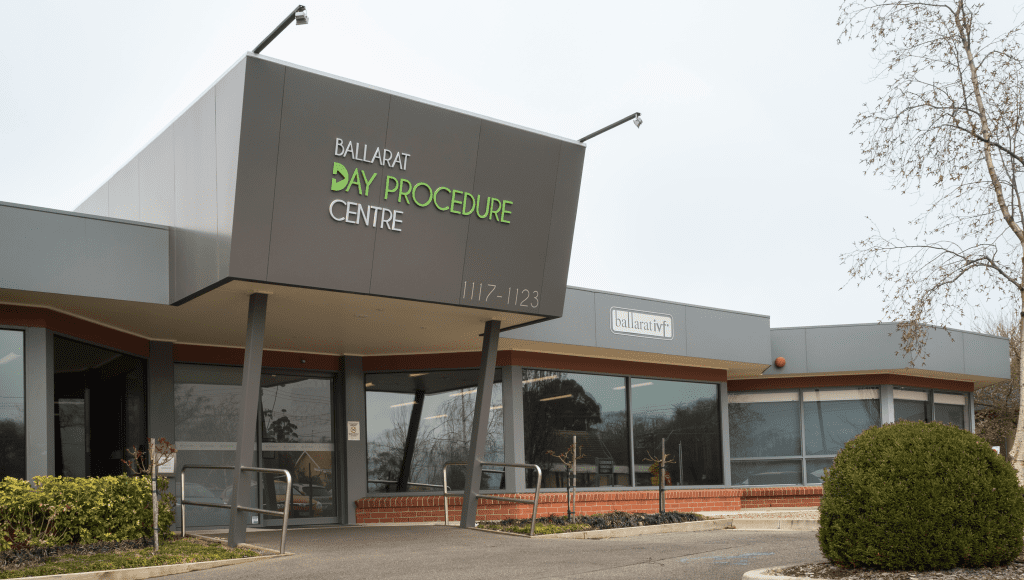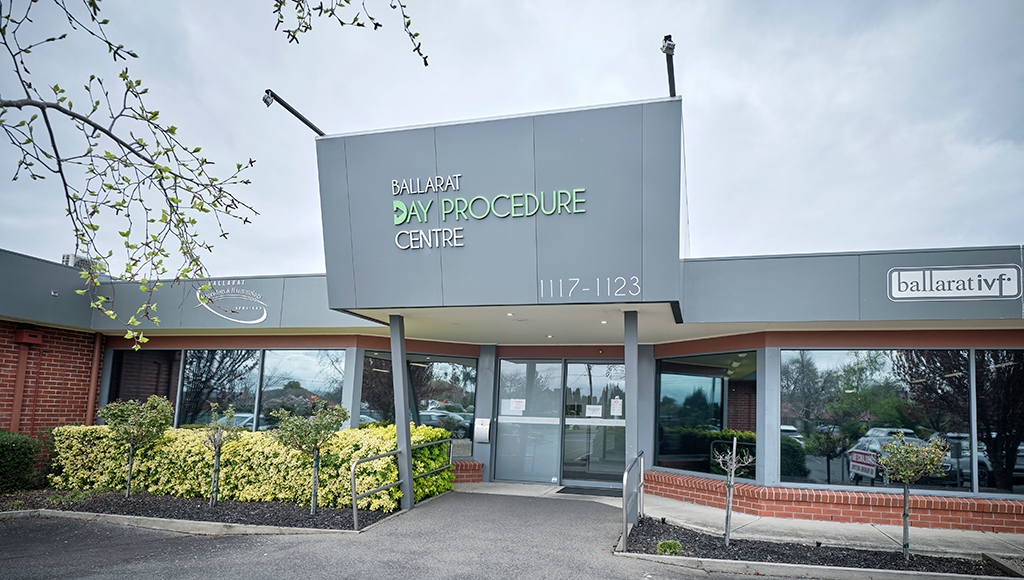Welcome to Ballarat Day Procedure Centre
Ballarat Day Procedure Centre provides patients with the highest level of care, effective treatment and sound management. It is the prime objective of the Centre to provide quality care in a safe, skilled, caring and supportive environment, which safeguards the privacy and rights of our patients and their families.

- Patient Information
- Find a Doctor
- Patient Feedback
- Australian Charter of Healthcare Rights
- Patient Safety and Quality
- Governance
- Online admissions
- Our Procedures
Adenoidectomy is a surgical procedure performed to remove the adenoids (a mass of lymphoid tissue located behind the nasal passages).
Cautery of septum, or nasal cauterisation, is a procedure in which the mucous membranes in the nose are cauterised in order to treat nosebleeds (epistaxis).
Functional endoscopic sinus surgery (FESS) is a surgical treatment for some diseases of the nose and paranasal sinuses. It is usually undertaken as surgical treatment for sinusitis and nasal polyposis, including fungal sinusitis.
Laryngoscopy refers to a procedure used to view the inside of the larynx (the voice box).
Rhinoplasty is a surgical procedure which improves the appearance or function of the nose by reshaping the nasal bone and cartilage. It is performed by either an Otolaryngologist – head and neck surgeon, Maxillofacial surgeon, or Plastic surgeon.
Septoplasty is a corrective surgical procedure undertaken to straighten the nasal septum (the partition between the two nasal cavities).
In chronic cases of otitis media with effusions present for months, surgery is sometimes performed to insert a grommet, called a “tympanostomy tube” into the eardrum to allow air to pass through into the middle ear, and release any pressure build up and help clear excess fluid within.
A Colonoscopy is an examination of the colon (large intestine) using a long, thin, flexible tube with a camera called a colonoscope.
A gastroscopy is an examination of the upper digestive tract (the oesophagus, the stomach and duodenum) using a long, thin, flexible tube with a camera called a gastroscope.
There is no one recommended screening test for gastric cancer. Screening and diagnostic tests for oesophageal and gastric cancer can be performed via endoscopy. Other screening methods include barium swallow/upper GI x-ray or endoscopic ultrasound.
Polyps are growths on the inside of the colon or gastrointestinal tract and are very common. A polypectomy can be performed during a colonoscopy or gastroscopy procedure.
Open hernia repair is the procedure performed to repair hernia by pushing the hernia back in place through an abdominal incision.
Wedge resection toenail is the surgical treatment for an ingrown toenail.
Endometrial Ablation is a procedure that surgically removes the lining of the uterus in order to reduce, or stop menstrual flow.
A hysteroscopy is the procedure in which a thin, lighted tube is used to examine the inside of the uterus and cervix. Hysteroscopy can be used in the diagnosis and treatment of several conditions such as abnormal bleeding, polyps or tumours inside the uterus, and adhesions.
Also known as ‘key-hole’ surgery, a laparoscopy is the procedure in which a laparoscope containing a fibre-optic camera and/or surgical heads is inserted through a small incision in the abdomen. Some of the many problems which can be diagnosed or treated by laparoscopy are infertility, reproductive problems, ectopic pregnancy, urinary disease and liver and pancreas cancer.
LLETZ stands for large loop excision of the transformation zone (of the cervix). In this procedure, the surgeon will remove a small segment of the cervix (the lower part of your womb or uterus) for examination.
Trans-vaginal tape repair is a surgical treatment for female stress incontinence. The procedure combines the use of mesh tape and a sling to support the urethra.
Oocyte Pick Up (OPU) is the surgical procedure in the IVF cycle in which the eggs are collected or retrieved.
A sperm aspiration procedure from the epididymis (PESA).
Sperm aspiration from the testicle (TESA).
A blepharoplasty is a procedure which removes excess or sagging skin from upper and/or lower eyelids. The surgery is usually performed for cosmetic reasons however; it can improve sight in patients whose eyelids are obscuring their vision.
A canthoplasty is a surgical procedure that tightens the area around the eye in order to correct a drooping appearance, and create an upward slant in the outer corner of the eye.
Ectropion is a medical condition where the eyelid folds outward. Corrective surgery involves the removal of a small piece of the fold to tighten the muscles in the area.
Entropion is a medical condition where the eyelid folds inward. Corrective surgery involves the removal of a small piece of the fold to tighten the muscles in the area.
Ptosis is a drooping of the upper eyelid. Corrective surgery is performed by tightening the levator muscle through an incision in the normal crease in the upper lid.
Tarsorraphy is a procedure in which the eyelids are partially sewn together in order to protect the eye (in most cases the cornea).
A wedge excision is a procedure which removes cancers from the edge of the eyelid.
A blood transfusion is defined as the transfer of blood from a healthy person to a patient.
A Bone Marrow Biopsy is a procedure in which a sample of the bone marrow is taken for testing to identify infection or disease in the bone marrow.
Chemotherapy is the use of anti-cancer drugs to destroy cancer cells.
Venesection, or phlebotomy, is the removal of blood from the body (usually through an incision or needle) for analysis or donation. It can be used as a treatment for haemochromatosis and polycythemia.
Cataract surgery is the surgical replacement of a cloudy lens with an artificial intraocular lens (IOL) implant to restore vision. The cloudy lens is broken up and removed with an ultrasound probe through a very small incision in the eye, and the artificial lens is inserted.
Intravitreal injections are used in the treatment of Age-Related Macular Degeneration. The Injections work by inhibiting the growth of abnormal blood vessels at the macula, and help to prevent leakage of these blood vessels.
A pterygium is a growth of blood vessels and fibrous tissues covering the surface of the eye due to over-exposure to sunlight over an extended period of time. A pterygium is treated with a surgical excision and an auto-conjunctival graft.
Squint surgery involves tightening the extraocular eye muscles to change the eye position in order to correct a turned eye.
A temporal artery biopsy is the most common diagnostic test for giant cell arteritis.
Glaucoma is characterised by elevated intraocular pressure associated with optic cupping and visual field loss. Trabeculectomy surgery lowers intraocular pressure by forming a new drainage to allow fluid to escape from the eye.
Vitrectomy is a surgery which removes the vitreous gel from the eye to assist in the repair of retinal detachments, macular holes and retinal membrane surgeries.
When wisdom teeth have the potential to cause problems or become impacted, they may be removed surgically. In the procedure, the surgeon makes a small incision and extracts the tooth with forceps.
A tooth extraction is the removal of a tooth from the dental alveolus (socket) in the alveolar bone.
Anterior cruciate reconstruction (ACL reconstruction) is a common procedure tin which a graft is used to reconstruct the ligament in the knee.
An arthroscopy is a procedure in which an endoscope is inserted in a joint through a small excision in order to diagnose and treat a number of conditions. An arthroscopy can be performed on a knee, shoulder, wrist or ankle.
Endoscopic carpal tunnel release surgery is the use of an endoscope to cut the transverse carpal ligament. The endoscope is usually inserted through a small incision in the palm.
Carpal tunnel release is a surgery used to treat carpal tunnel syndrome. During the surgery, the surgeon will cut the carpal ligament to relieve pressure on the median nerve, and make more space for the nerve and tendons.
Dupuytren’s contracture is the development of a fibrous connection between the finger tendons and the skin of the palm resulting in a forward curvature or ‘clawing’ of one or more fingers. Treatment for Dupuytren’s contracture includes needling, injections and surgical procedures to sever the tissue causing the contracture.
Labral reconstruction is a procedure in which the native labrum is reconstructed using a graft.
Lateral release surgery is a procedure performed on the knee to realign the patella (kneecap). It is usually performed as an arthroscopic procedure.
Meniscal repair is a surgical procedure performed to repair torn knee cartilage.
An open reduction and internal fixation (ORIF) is a procedure in which the fracture is reduced and fixated using wires, plates or screws.
Partial knee replacement surgery can help manage arthritis pain that hasn’t responded to other treatments. It involves the replacement of a damaged part of your knee joint. It has a shorter recovery time than full knee replacement surgery but isn’t right for everyone.
Rotator cuff repair procedures are most commonly performed by arthroscopic surgery, however in some cases open shoulder surgery may be necessary. The procedure involves removing any loose fragments from the area, and then surgically repairing the tendon.
Subacromial decompression is a procedure used to treat shoulder impingement, usually by reshaping a part of the shoulder blade.
Synovectomy is the surgical removal of the inflamed synovium (the tissue lining the joint), and is usually performed with an arthroscopy. The surgery is usually performed in cases of inflammatory arthritis where there is swelling causing pain, or limiting the range of motion of the digits and thumb.
An excision of lesion procedure is the surgical removal of a skin lesion. Skin lesions can be any lumps on the skin including moles, cysts, warts or skin tags.
Otoplasty, also known as ear correction surgery or ‘ear pinning’, is performed to move prominent or protruding ears closer to the head. It is done using permanent sutures to hold the ears in place.
The circumcision procedure (for infant males) involves the use of a Plastibell (a small plastic ring) which is slipped over the glans, and the foreskin is laid over it.
A cystoscopy is a procedure in which a thin flexible tube with a camera and light on the end is inserted through the urethra and into the bladder. The procedure is most commonly undertaken to investigate the bladder for any abnormalities.
Urodynamics involves bladder and urethra assessments
As with endovenous laser ablation (EVLA), radiofrequency ablation (RFA) relies on thermal (heat based) damage to the vein, that leads to immediate closure of the vein. Once the vein is treated by radiofrequency ablation, it will gradually undergo complete absorption by the body and disappear over time.
Contact Details
Opening Hours: 6:30am to 5:00pm, Monday to Friday. Our friendly personnel are always ready to assist with your enquiries.
Tel: (03) 5338 2666
Contact Person: Harpinderpal Jassar, CEO/Director of Nursing [email protected]
Address: 1119-1123 Howitt Street Wendouree VIC 3355
- Follow Ballarat Day Procedure Centre on social





